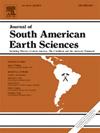通过矿物化学揭示岩浆演化和混合:来自巴西borborrema省南部macurur地区Riacho do Mingu同长岩的见解
IF 1.7
4区 地球科学
Q3 GEOSCIENCES, MULTIDISCIPLINARY
引用次数: 0
摘要
Riacho do Mingu Stock (RMS)位于macurur本文章由计算机程序翻译,如有差异,请以英文原文为准。
Unravelling magmatic evolution and mixing through mineral chemistry: insights from the Riacho do Mingu syenitic stock, Macururé Domain, southern Borborema Province, Brazil
The Riacho do Mingu Stock (RMS) is a syenitic intrusion with evidence of mixing, located in the northern part of the Macururé Domain. In the syenites, a porphyritic texture occurs with alkali feldspar phenocrysts embedded in a matrix composed of biotite, amphibole, plagioclase, and quartz. Enclaves in the RMS are predominantly micaceous, with amphibole and plagioclase. The plagioclase crystals from the stock exhibit variations in XAn content from 0 to 17 % in the syenites and from 0 to 47 % An% in the enclaves. By applying physicochemical parameter inference equations available in the literature for amphibole crystals, pressures of 2.5–4.8 kbar were identified in the syenites and from 2.4 to 9.1 kbar in the enclaves, suggesting greater depths for the mafic magma. Estimated temperatures range from 672 °C to 876 °C in the syenites and from 675 °C to 830 °C in the enclaves. The biotite crystals crystallized between 585 °C and 646 °C at pressures of 0.9–2.3 kbar. The amphibole chemistry data in the enclaves suggest a mantle origin for most specimens, while some crystals may have incorporated crustal material. The amphibole in the syenite has a mixed mantle-crust source. The higher temperature in the enclaves may reflect an origin in a mantle magma that came into contact with the trachytic liquid of the chamber at around 18 km depth. The studied biotite points to magmas of calc-alkaline affinity, reinforcing a collisional environment with a mixture of crustal and mantle sources. Until now, syenitic rocks with features belonging to the Serra do Catu Suite had not been found in the Macururé Domain; being previously restricted to the Canindé Domain, located further north. Therefore, the presence of unique features is observed in the Macururé Domain, representing a contribution to the southern portion of the Borborema Province.
求助全文
通过发布文献求助,成功后即可免费获取论文全文。
去求助
来源期刊

Journal of South American Earth Sciences
地学-地球科学综合
CiteScore
3.70
自引率
22.20%
发文量
364
审稿时长
6-12 weeks
期刊介绍:
Papers must have a regional appeal and should present work of more than local significance. Research papers dealing with the regional geology of South American cratons and mobile belts, within the following research fields:
-Economic geology, metallogenesis and hydrocarbon genesis and reservoirs.
-Geophysics, geochemistry, volcanology, igneous and metamorphic petrology.
-Tectonics, neo- and seismotectonics and geodynamic modeling.
-Geomorphology, geological hazards, environmental geology, climate change in America and Antarctica, and soil research.
-Stratigraphy, sedimentology, structure and basin evolution.
-Paleontology, paleoecology, paleoclimatology and Quaternary geology.
New developments in already established regional projects and new initiatives dealing with the geology of the continent will be summarized and presented on a regular basis. Short notes, discussions, book reviews and conference and workshop reports will also be included when relevant.
 求助内容:
求助内容: 应助结果提醒方式:
应助结果提醒方式:


